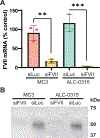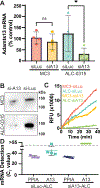Comparison of DLin-MC3-DMA and ALC-0315 for siRNA Delivery to Hepatocytes and Hepatic Stellate Cells
- PMID: 35642083
- PMCID: PMC9621687
- DOI: 10.1021/acs.molpharmaceut.2c00033
Comparison of DLin-MC3-DMA and ALC-0315 for siRNA Delivery to Hepatocytes and Hepatic Stellate Cells
Abstract
Ionizable cationic lipids are essential for efficient in vivo delivery of RNA by lipid nanoparticles (LNPs). DLin-MC3-DMA (MC3), ALC-0315, and SM-102 are the only ionizable cationic lipids currently clinically approved for RNA therapies. ALC-0315 and SM-102 are structurally similar lipids used in SARS-CoV-2 mRNA vaccines, while MC3 is used in siRNA therapy to knock down transthyretin in hepatocytes. Hepatocytes and hepatic stellate cells (HSCs) are particularly attractive targets for RNA therapy because they synthesize many plasma proteins, including those that influence blood coagulation. While LNPs preferentially accumulate in the liver, evaluating the ability of different ionizable cationic lipids to deliver RNA cargo into distinct cell populations is important for designing RNA-LNP therapies with minimal hepatotoxicity. Here, we directly compared LNPs containing either ALC-0315 or MC3 to knock-down coagulation factor VII (FVII) in hepatocytes and ADAMTS13 in HSCs. At a dose of 1 mg/kg siRNA in mice, LNPs with ALC-0315 achieved a 2- and 10-fold greater knockdown of FVII and ADAMTS13, respectively, compared to LNPs with MC3. At a high dose (5 mg/kg), ALC-0315 LNPs increased markers of liver toxicity (ALT and bile acids), while the same dose of MC3 LNPs did not. These results demonstrate that ALC-0315 LNPs achieves potent siRNA-mediated knockdown of target proteins in hepatocytes and HSCs, in mice, though markers of liver toxicity can be observed after a high dose. This study provides an initial comparison that may inform the development of ionizable cationic LNP therapeutics with maximal efficacy and limited toxicity.
Keywords: RNA therapy; gene therapy; hemostasis; nanomedicine; thrombotic thrombocytopenic purpura; von Willebrand factor.
Conflict of interest statement
Conflict of interest disclosure
CJK is a director and shareholder of NanoVation Therapeutics, Inc., which is developing RNA-based therapies. AWS, LJJ, FF and CJK have filed intellectual property on RNA-based therapies with the intention of commercializing these inventions. LGP and JPL declare no conflicts of interest.
Figures



References
Publication types
MeSH terms
Substances
Grants and funding
LinkOut - more resources
Full Text Sources
Other Literature Sources
Medical
Research Materials
Miscellaneous

